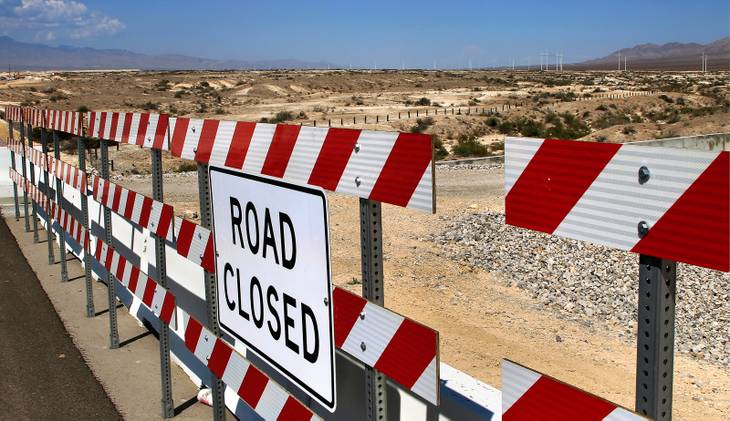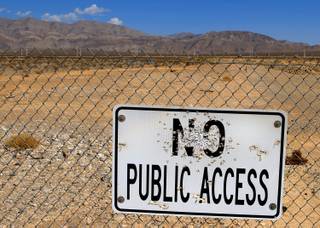Developer Gregg Wolin has been in the real estate business for 25 years, but few projects have tested his “humanity” and “ethical fiber” as much as Park Highlands in North Las Vegas.
The sprawling development, long seen as an economic boon to the city, went bankrupt twice before a single house was built. After the economy tanked, the land was chopped up among numerous buyers, all of whom had veto powers over project plans.
Park Highlands has been in the works for almost a decade and was estimated to cost more than $3 billion. But delays piled up because of the recession and the rotating cast of investors pursuing different agendas, according to people involved in the project. It’s been so convoluted that Wolin wants to write a book about it and figures it'd make a great film.
“I may make more money on the movie rights than actually developing the property,” Wolin said.
Today, Park Highlands is split between two groups pursuing two separate projects — the roughly 2,000-acre Villages at Tule Springs, by Wolin’s group, and the roughly 600-acre Park Highlands West, owned by a cluster of investors.
And by next year, landowners say, construction could be underway at both, part of a broader effort to revive sprawling residential developments in Southern Nevada that fizzled during the downturn.
Wolin, co-founder of Crescent Bay Holdings in Scottsdale, Ariz., says there’s “no reason we can’t have dirt flying” in the first half of 2016 at the Villages, which today consists of open desert.
At Park Highlands West, where construction crews installed utilities, graded roads and did other work before everything flopped, homebuilding “could start in mid-to-late 2016,” says Joe Aguirre, spokesman for Irvine, Calif.-based SunCal, the largest landowner there.
“We are all very much looking forward to the day when we will break ground on this new community,” Aguirre said in a statement.
They won’t be finished anytime soon. Building the Villages, for instance, could take up to 15 years, “depending on how the market recovers,” Wolin said.
Southern Nevada’s once-roaring homebuilding industry was all but wiped out by the recession and still has its up and downs. Sales rose fast from the depths of the downturn for a few years, then fell hard in 2014 but now are rising again.
Business this year “has not been at a rapid pace, but rather a slow, stable positive trek, trying to get to a level where we might classify it as a ‘normal’ housing market,” Dennis Smith, founder of Las Vegas-based Home Builders Research, said in a report last month. “However, in our opinion that is still months and maybe years away.”
Perhaps boosting things is the availability of cheap money: Interest rates are low, lenders are issuing more mortgages in Las Vegas and buyers here are making smaller down payments.
Moreover, Las Vegas’ homebuilding market is dominated by large, publicly traded companies such as Lennar Corp. and KB Home. Builders buy land in master-planned communities to develop subdivisions, and whenever there’s an uptick in demand for new homes, there’s plenty of money out there “to take advantage of it,” Wolin said.
Park Highlands isn’t the only community to rise from the dead. Other mini-cities that got derailed during the recession but now are back in business include 2,200-acre Cadence in Henderson, 1,700-acre Skye Canyon in northwest Las Vegas, and 1,900-acre Inspirada in Henderson. Also, an hour’s drive north of Las Vegas, developers of Coyote Springs — which has been planned for at least 15 years but has almost nothing besides an 18-hole golf course — are looking to revive the long-stalled, 43,000-acre project.
But unlike other big projects in the valley that stumbled, Park Highlands, straddling the 215 Beltway near Aliante resort, has been slower to get back on its feet.
“It’s like with anything,” said Gina Gavan, director of economic and business development for North Las Vegas. “You can’t really get to decisions when there’s too many cooks in the kitchen.”
• • •
During the boom years last decade, investors shelled out hundreds of millions of dollars at government auctions for land, with plans for massive projects. Developer John Ritter’s Focus Property Group, for instance, led a group that paid $510 million in February 2005 for roughly 1,700 acres in northwest Las Vegas. Ritter outbid Olympia Cos. founder Garry Goett for the property, but in November 2005, Goett outbid Ritter for Park Highlands, leading a group that paid $639 million.
The bidding reportedly was fierce, with the price swelling by tens of millions of dollars each second.
Las Vegas was one of the fastest-growing metro areas in the country last decade, fueled in no small part by North Las Vegas, whose population soared 65 percent from 2000 to 2005, to about 190,000. The real estate market was white-hot, and perhaps few people, if anyone, doubted Park Highlands’ potential.
North Las Vegas officials wanted it to have a more affluent bent than the neighboring Aliante community, and the project was led by Goett, who developed the Southern Highlands community in the south valley and had "a great track record,” lobbyist Bob Gronauer, who’s been involved with Park Highlands since the beginning, said recently.
“Everything was very positive,” he said.
There was “always the possibility, however remote, that the raw land will not be developed into finished lots,” analysts with bond-ratings firm Moody's Investors Service said in a report in early 2006. But, they added, it seemed that “each additional casino or hotel that is built ... tends to support a growing housing market.”
Moreover, Goett’s group paid a discount compared with previous federal auctions, which should help "provide a bit of added cushion in case the housing market in Las Vegas were to weaken unexpectedly,” the analysts wrote.
When the bubble burst, Southern Nevada was one of the hardest-hit areas of the country, and few cities locally were pummeled as hard as North Las Vegas, whose leaders declared a fiscal emergency.
By early 2012, 31 percent of U.S. homeowners with mortgages were underwater, meaning their debt outweighed their home value. In Southern Nevada, 71 percent of borrowers were upside-down at the time, but in North Las Vegas itself, roughly 81 percent were underwater, according to Zillow.
By early this year, 25 percent of homeowners in Southern Nevada were underwater, with around 31 percent of North Las Vegas upside-down, double the national average.
Plans call for the Villages to have at least 8,600 homes, Gavan said. That would include a number of higher-end, semi-custom or custom homes, and the project site is near its new namesake, the Tule Springs Fossil Beds National Monument, a fossil-rich area that received the federal designation in December.
It’s also the city’s largest residential project in the pipeline, Gavan said.
Last year, when developers were proposing to split Park Highlands, Mayor John Lee said they were “showing America ... that we're open for business again.”
• • •
Park Highlands’ previous plans called for 15,750 homes, as well as schools, fire and police stations, a library, and 130 acres of parks and trails. Construction reportedly began in 2007, but when the market tanked, so did master-planned communities.
Ritter, for instance, lost his 1,700-acre site to foreclosure in 2008 without having built a thing. Goett, backed by New York investment firms, later acquired the property from lenders and is now developing it as Skye Canyon.
Local officials didn't give up hope for Park Highlands.
“North Las Vegas is transitioning from a blue-collar, high-crime perception to more of a fast-paced professional-quality-development type of community,” then-City Manager Gregory Rose said in 2008. “I believe Park Highlands helps this transition as a community.”
Goett, however, filed bankruptcy protection for the project in 2009. Hillwood Communities in Dallas later acquired the project's holding company, and then in 2011, Park Highlands went bankrupt again.
The real estate industry was on life support, and property in Park Highlands sold for next to nothing. Original investors lost “hundreds of millions of dollars,” said former North Las Vegas Mayor Mike Montandon, who acquired some 70 acres in Park Highlands a few years ago with a partner.
“It went down pretty hard on them,” said Montandon, a real estate industry veteran.
Wolin’s Crescent Bay, backed by Newport Beach, Calif., investment firm KBS, bought 1,375 acres — half the site — at a bankruptcy auction for $21 million, in what lobbyist Gronauer said was “a daylong bidding war” with Hillwood.
Hillwood President Fred Balda did not respond to requests for comment.
His company is part of a lengthy list of landowners who have come and gone or still hold stakes. They include Las Vegas homebuilder Larry Canarelli, founder of American West Homes; New York investment firm Angelo, Gordon & Co.; Irvine, Calif.-based builder Standard Pacific Homes; Goett’s Olympia; SunCal; Montandon and former business partner Jim Zeiter, whose property has since been carved out of the project borders; and Texas-based homebuilder D.R. Horton.
When asked whether it’s tough keeping track of everyone, Gronauer laughed.
“Yeah, it is,” he said.
By nature, the project wasn’t going to be easy — the site is sliced into chunks by the Beltway, existing neighborhoods and separately owned land. And despite the large group of investors, no one was appointed after the bankruptcies to oversee everything, and anyone could block plans for the project.
It was like a partnership with no operating agreement, or a company with no bylaws — just “a bunch of shareholders with no management,” Wolin said.
Last year, however, the investors received City Council approval to split the project into two parts. Crescent Bay controls 90 percent of the Villages at Tule Springs, but Park Highlands West is more fractured. SunCal owns about 200 of the 600 acres, and four other groups control the rest, SunCal's Aguirre said.
During the recession, Crescent Bay wanted to buy property here when others were shying away, and even though North Las Vegas was viewed as being “in terrible shape,” that didn’t mean the city would never recover, Crescent Bay co-founder Geoff Beer said.
“That was our belief when we bought the land,” he said.
Wolin, for one, isn’t convinced that their heavily discounted deal was as much of a steal as he initially thought.
“It will be an OK deal in the end,” he said.
The project has moved slowly, but it’s alive, and the Villages has a new, recently approved development agreement with the city, a key, early step for any major project.
“Getting to where we are today,” Gronauer said, “is just a miracle.”


